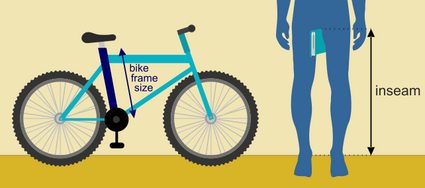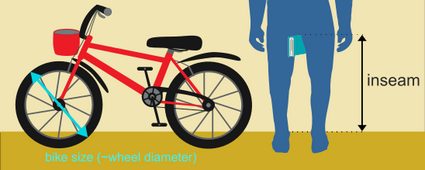Bike Size Calculator
With this bike size calculator, you can estimate the bike size of your new bike in the blink of an eye. Just choose the type of bike — road, mountain, or general-purpose city/trekking bike, input your height and inseam, and we will recommend some bike frame sizes for you to take into consideration. With our tool, you can also find a perfect bike fit for your child. If you're not sure how to measure an inseam or are still wondering, "What size bike frame do I need?", just read on to find the answer. Also, we've prepared a bike size chart, where you can find suggestions for mountain and road bike frame sizes.
💡 After buying a bike, check out the calories burned calculator to see how much energy you've used!
Coronatimes — when bikes🚴 become the new toilet paper🧻
At the beginning of the pandemic, people were hoarding toilet paper, and then .
With public transport services heavily reduced and the risk of having people in close proximity, many of us are choosing cycling as an alternative way of commuting. Also, many ride bikes to preserve their mental and physical health, while also observing social distancing. We know that any amount of activity can work wonders, especially in these hard times. How long can you happily stay at home, only binge-watching, eating, and reading dozens of books? It's awesome, but physical activity is a must for both our physical and mental health.
Even if you were not into pedaling before the pandemic, it's probable that the time has finally come — you need to buy a bike 🚴. But how do you choose one if you last cycled many years ago or never at all? As a lot of shopping has shifted to the internet, you'll likely have no option of testing the bike before you buy it. This is where we come in handy. This bike size calculator helps you estimate your biking needs. Of course, a professional fit with a bike expert would be much better, but unusual times call for extraordinary solutions.
Of course, cycling doesn't have to be everyone's cup of tea. If you prefer walking, you can use our steps to miles calculator to see how many steps you need to take to cover the desired distance. Alternatively, if you happen to own a home gym, check the bench press calculator to see how your rep max improves over time!
Types of bikes
OK, you've taken the first step — you're buying a bike. But... what now? How do you know which bike is the right one for you? To facilitate your decision, here is a short description of the three most popular bike types:
1. Road bike / Gravel bikes
Road bikes are designed for smooth surfaces, like paved roads and bike lanes. They're usually lighter than other types of bikes. Their tires are narrow, and their handlebars are bent ("dropped"). Gravel bikes, a hot trend, can also handle unpaved tracks and rugged terrain.

2. Mountain bike
You should choose a mountain bike if you are looking to bike through varied or off-road terrain. Mountain bikes have flat handlebars and wide tires, while higher-end models may include suspension for added grip and comfort.

3. City / trekking / hybrid bike
This category includes all other bikes. They are a compromise between mountain and racing bicycles, with a focus on comfort and low maintenance. Depending on the model's characteristics, it may be used for recreational purposes, as well as commuting or errands.

Of course, there are many different bike types that we don't describe here — BMX, triathlon, folding, or recumbent bikes, to name only a few. But we believe that these three types are more than enough for a first-timer (or purchasing online).
How to calculate a bike size? Measure your inseam!
To find out your recommended bike size, you first need to measure your inseam — that is your inside leg measurement. Simply speaking, the inseam length is the distance from the floor to your crotch. So, how to measure the inseam properly?

- Stand close to a wall; your feet should be 6-8" (15-20 cm) apart.
- Place a large, hardcover book between your legs — it will simulate the saddle.
- Mark where the book's spine touches the wall.
- Measure the distance from that point to the floor — that's your inseam.
Some formulas or charts use only the rider's height, but this leads to a less accurate estimation — you can have short, long, or "average" length legs. As many different formulas exist, this bike size calculator won't show you only one number but other frame sizes that may fit.
What bike size do I need?
With this bike size calculator, we'd like to give you an idea of which sizes of bike frames you should look at. But first, we need to start with a general disclaimer — you should treat this tool as a guideline only. There are many different bike brands and models, so frames and general structure may vary a lot between them. Also, every cyclist is built slightly differently and may have particular needs and preferences.
The frame size is usually measured as the distance between the top of the seat tube (where the seat clamp holds the seat post) and the center of the bottom bracket. Sometimes, the center or top of the top tube is chosen as the first point.

Our bike size calculator determines bike frame sizes on the basis of your inseam measurement. The formulas vary for different types of bikes:
1. City/trekking bike frames
Trekking frame size = inseam [cm] × 0.64
2. Road bike frames
Road frame size = inseam [cm] × 0.67
This is the formula created in the '80s by , a famous French coach and former pro cyclist.
3. Mountain bike frames
Mountain bike frames are smaller than road bike frames. Usually, a frame shorter than 4-5 in (10-12 cm) is a good start.
Mountain frame size = Road frame size − 11 [cm]
You probably noticed that the formulas don't directly take your height into account. However, when you enter or choose your height into our bike size calculator, a probable range of your inseam will appear (on average, it's around 47% of your height). This bike size calculator is suitable for both men and women.
To find a child's bike size, we also consider the length of their inseam. However, children's bike sizes are expressed differently—not by frame but by wheel size.

Tips for buying a bike 🚴
Before buying a bike, remember to research, think for a while, and answer these three crucial questions:
-
What do I need a bike for? Ask yourself what you are going to use your new bike for, and over which terrain that will take you — paved roads, gravel, or off-road? City or nature trails? You can find some hints in the Type of a bike paragraph above.
-
How much do I want to spend? You can buy a bike not only for $300 but also for $3000, so decide on your budget first. That leads us to the next tip...
-
Do I want a used or a new bike? If you'd like to buy a better quality bike that is unfortunately too expensive, you can always search for used bikes. Just be careful you are not scammed — maybe your friend wants to sell one, or does a local shop have some ex-display models?
After finding the type of bike you'd like to buy (and can also afford):
-
Find the right size bike — our bike fit calculator will help you with that. Also, checking the manufacturer's site can be helpful, as brands and models may differ, and detailed dimensions are sometimes available. Note, that some manufacturers make a distinction between men's and women's models — the difference can be as trivial as the bike's color, but it may be that the whole frame is constructed to better suit a woman's body.
-
Think about necessary accessories — don't spend your whole budget on the bike itself; you'll not only need to buy the essentials, like a helmet, lock, and lights but maybe some other useful things — a water bottle holder or a repair and maintenance kit.
-
Customize — remember that many bike parts can be swapped. So don't cross out an almost ideal fit — maybe the parts you don't like can be quickly and cheaply removed, e.g., the handlebars or wheels?
And, if it's possible:
- Test-ride a few different bikes. Purchasing a bike from a stationary shop has many advantages — apart from testing the bikes, you can ask for advice and recommendations. Don't hesitate to ask questions that will clear any doubts. Some shops even offer a bike-fitting service that can help you adjust your new purchase perfectly to your body.
Bike frame size chart
You can find gazillions of bike frame size charts on the Internet. The problem is that they can vary a lot. Here we propose some conservative estimates of mountain bike frames and road bike frames.
Inseam [in] | 25-25.5 | 26-27 | 27.5-28 | 29-30 | 30.5-31.5 | 32-32.5 | 33-34 | 34.5-35.5 | 36-37 | 37.5-38.5 |
|---|---|---|---|---|---|---|---|---|---|---|
Inseam [cm] | 64-65 | 66-69 | 70-72 | 74-76 | 77-80 | 81-83 | 84-86.5 | 87-90 | 91-94 | 95-98 |
Mountain bike [in] | 12-13 | 13-14 | 14-15 | 15-16 | 16-17 | 17-18 | 18-19 | 19-20 | 20-21 | 21-22 |
Road bike [cm] | 43-44 | 44-47 | 47-49 | 49-51 | 51-54 | 54-56 | 56-59 | 59-61 | 61-63 | 63-66 |
For kids' bikes, the table we've adapted looks as follows:
Inseam [in] | 14-17 | 16-20 | 18-22 | 20-24 | 22-25 | 24-28 | 28+ |
|---|---|---|---|---|---|---|---|
Inseam [cm] | 35-43 | 40-50 | 45-55 | 50-60 | 55-63 | 60-72 | 72+ |
Wheel size | 12" | 14" | 16" | 18" | 20" | 24" | 26" |
We hope that after reading that short article and using our bike size calculator, you will no longer wonder what size of bike frame/wheel you need. If this sparked your curiosity and you want more thorough information, a great place to find it is on the by Rinasclta bike. Just remember that all of these kinds of calculations should be taken with a pinch of salt — all in all, the best method is to try on different bikes. With professional bike fitting or even a simple trial and error process, you can find the perfect bike for you.
Different sizes for different purposes
You might have noticed that the recommended bike frame size will vary depending on the discipline you choose. This is partly because of how frames are designed but is mostly due to the different requirements and priorities in each discipline. If your position on the bike changes, so will the bike frame size.
Let's start with mountain biking, which can be divided into several categories, but all of them have many similarities: a fairly upright position, wide handlebars, and a strong emphasis on comfort and bike handling. This means that a mountain bike frame will tend to be smaller than its road equivalent, allowing you to jump over obstacles and easily throw the bike around when riding "the gnarl".
On the opposite side of the spectrum, we find road bikes. These, too, can be separated into many categories, with "endurance" machines on the comfy end and "Time Trial (TT)" bikes on the performance end. In general, though, the smoother surfaces, higher speeds, and narrower handlebars favor a more stretched position, with a larger distance between the saddle and handlebar.
However, keep in mind that these are only general remarks, with new developments and trends appearing constantly. Cutting-edge bikes might not follow these rules. Right now, road bikes are doubling down on the aerodynamic benefits of going low, narrow, and stretched out. Mountain bikes (especially enduro and do-all machines) are getting longer, lower, and slacker with every new model despite the humongous wide bars we tend to see fitted.
Don't try to fit your bike, make your bike fit you
As a final note, it is important to remember that it is the bike that needs to fit you, and not the other way around. This is particularly important when one size of frame is designed to suit different people. So, once you get the right frame size, remember to check and tune everything to fit your body.
The first and most natural thing to do here is to adjust the seat post height so that your leg is extended at the bottom of the pedal stroke while keeping a slight bend to your knee. This ensures optimal power output, and prevents knee problems, with the only trade-off being that you probably cannot reach the ground with your feet while seated in the saddle.
The next step is to think about the position of your stem, the size of your stem, handlebars, cranks... and even saddle position within the seat post. The options here are almost limitless if we take into account that swapping parts is generally inexpensive and can totally transform your fit.
As always, the recommended way to go about fitting a bike to your body is to get a professional bike fit. However, it may be very costly for most people, so the next best option is to go by feel and adjust things if you experience pain or discomfort after riding your bike. This is generally more than enough for everyone but the most committed amateur and professional cyclists, so try it yourself and find the perfect fit for you!
How do I measure my inseam to calculate the appropriate bike frame size?
To measure your inseam to determine the appropriate bike frame size, follow these steps:
- Stand close to a wall with feet 6-8 inches (15-20 cm) apart.
- Place a large book between your legs to simulate a saddle.
- Mark where the book's spine touches the wall.
- Measure the distance from that mark to the floor.
- Voilà! You have now measured your inseam.
What's the recommended bike frame size if I'm 183 cm tall?
Assuming you want to purchase a city bike, and your inseam length is around 81 cm (32 in), the recommended bike frame size would be 52 cm (20 in). If you wish to determine the bike frame size for different types of bikes, you can use the Omni Calculator's bike frame size calculator.
How do I determine the frame size for a trekking bike?
To determine the frame size for a trekking bike:
- Measure your inseam in centimeters.
- Multiply the measurement by 0.64.
- That's it! You have now determined the frame size for a trekking bike based on your inseam measurement.
How do I choose the type of bike that suits my needs?
You can select a bike based on terrain and intended usage. For instance, road bikes are ideal for smooth surfaces; mountain bikes are suitable for off-road adventures, and city/trekking bikes are known for their versatility. When choosing, consider factors such as speed, control, and comfort to match your preferences.